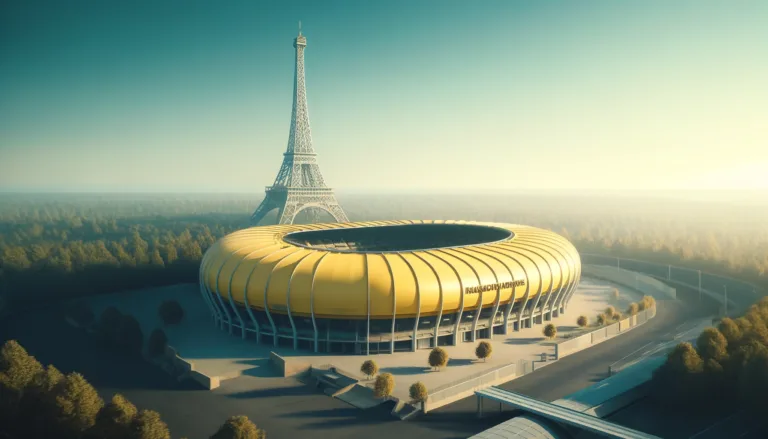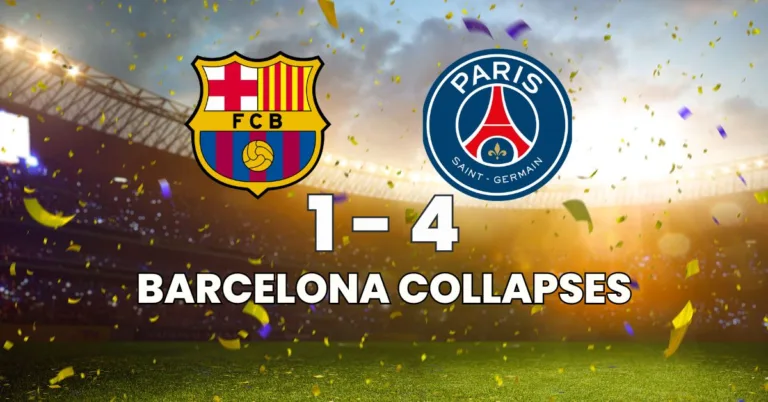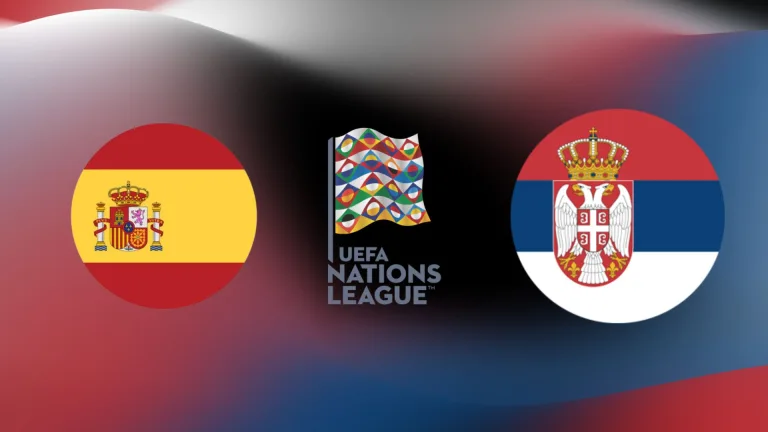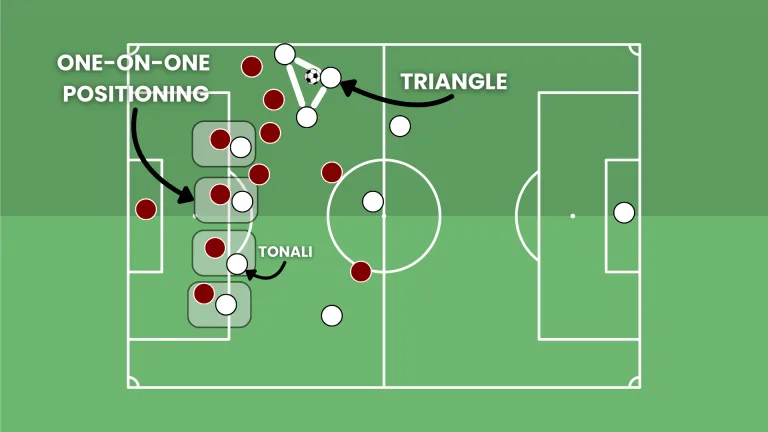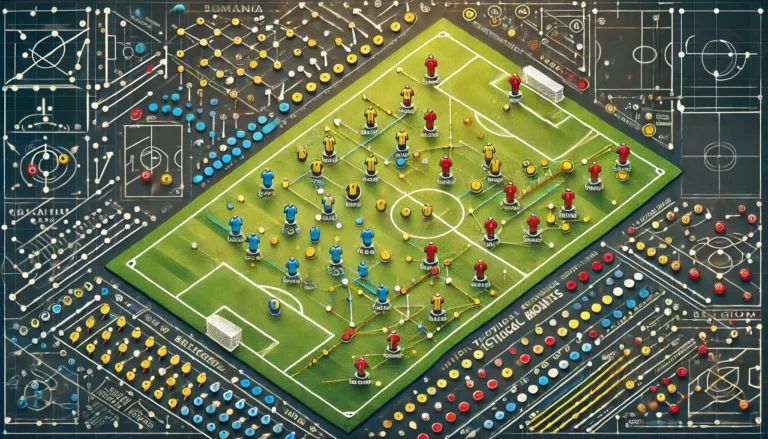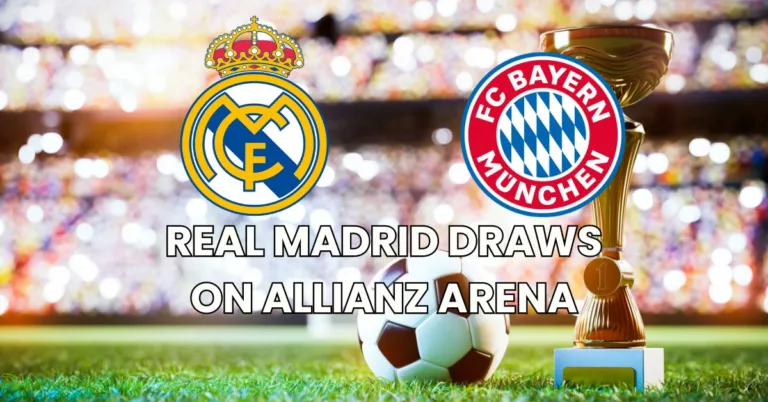Barcelona vs PSG – Tactical Masterclass by Luis Enrique and Xavi
One of the must-watch games of this Champions League round brings a victory for Barcelona at Parc des Princes. Barcelona vs PSG is a clash between two title contenders. Barcelona boasts a rich tradition in European cups, winning their last trophy in 2015, while PSG is tries to win its first Champions League trophy in Mbappé’s final season at the French club. Together with Manchester City and Real Madrid, this game was one of the most spectacular games of the year so far in European football.
Starting Lineups
Both teams opt for a 4-3-3 formation, and both PSG and Barcelona are affected by several injuries. One change we see at PSG is Marquinhos, who plays as a right-back to cover for Hakimi’s suspension and to who will try to counter Raphinha. From Barcelona’s side, Alejandro Balde is missing due to an injury earlier this year, as well as Gavi.
Another question mark from the Catalan camp is Andreas Christensen, who suffered an injury in mid-March and is still not fully recovered. He started as a substitute but came on the pitch in the 76th minute.
PSG Tries to Spread its Wings but Barcelona Scores in the First Half
The beginning of the match is dominated by PSG, who, as expected, use the flanks for build-up play. The reason for this choice is evident, as it’s where PSG’s most dangerous players, namely Mbappé and Dembélé, are positioned. Thus, we can see PSG attempting to congest the right side to draw in Barcelona’s compact defense, followed by switching the flank to Mbappé.
This tactic is a classic one to try to create space against a compact low-block defense. However, it requires quite a bit of care, as it doesn’t take long for Raphinha to exploit the advanced position of the full-backs. He runs in behind the French defense line and receive a precise long ball, but Donnarumma’s intervention saves PSG from an early goal.
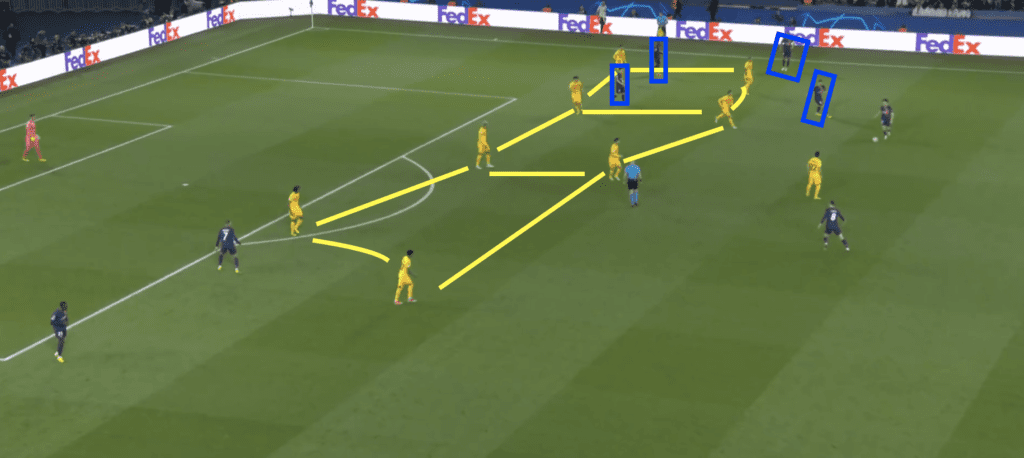
This attacking approach by PSG was predominant in the first half. The real danger from PSG’s camp originated from actions by Dembélé on the right flank, where he managed to deliver the ball into the space left open at the edge of Barcelona’s penalty area. At the same time, Mbappé moves into the center of the box, forcing the central defenders to stay close to him. We can observe that all the shots in the first half towards ter Stegen’s goal came from the right edge of the box. However, PSG failed to score from this position in the first half.
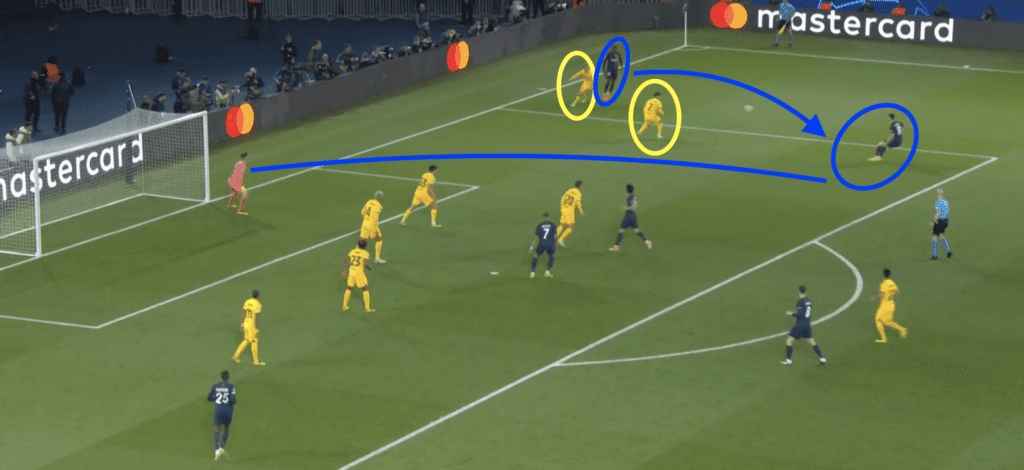
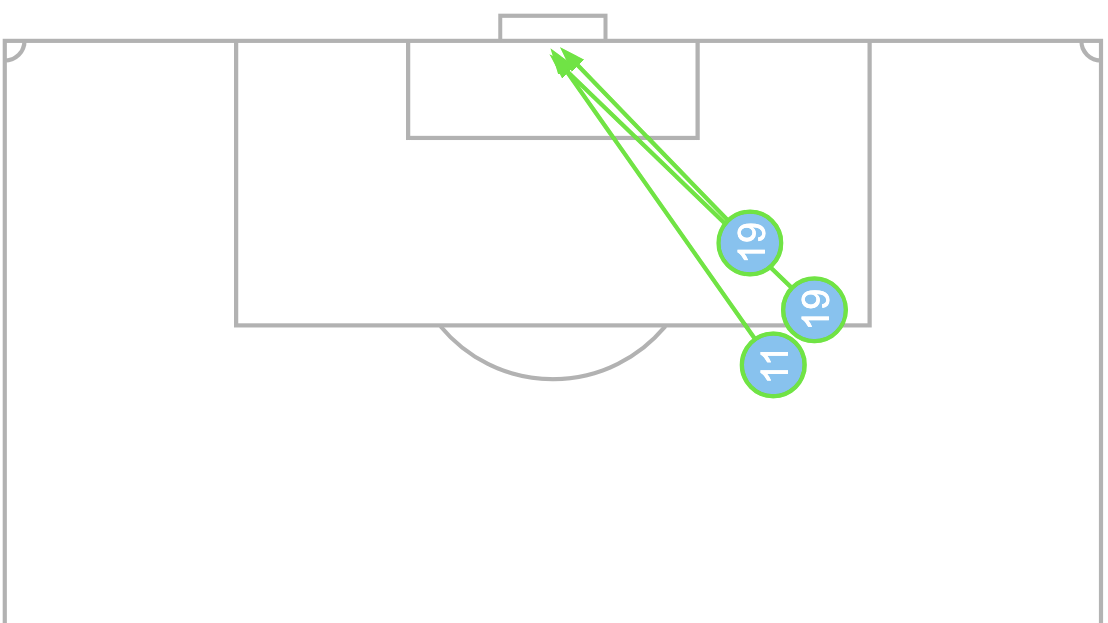
On the other wing, Mbappé failed to make an impact, having a match without a single shot on target. This was due to Barcelona’s defensive shape, which shifted very well from one wing to the other. Kounde, aided by Araujo, managed to mark Mbappé tightly and not allow him any space or passing lanes for his famous passes into the box.
It’s no secret that both Luis Enrique and Xavi love to play offensively, using high pressing, as Pedri stated after the match. The first goal of the match comes in the 37th minute, where Barcelona managed to exploit PSG’s high press with a long pass directly from the defensive line to Lewandowski in the center of the pitch. He navigates very well through the midfield being chased by two players and sends the ball out wide to Yamal.
After the pass, Lewandowski positions himself well between the two center-backs to force them to keep up with him, leaving the left wing open, and Yamal delivers a spectacular curved pass that makes Donnarumma to come out and try to clear the ball, but Raphinha comes from that empty space left on the wing and scores the first goal of the evening.
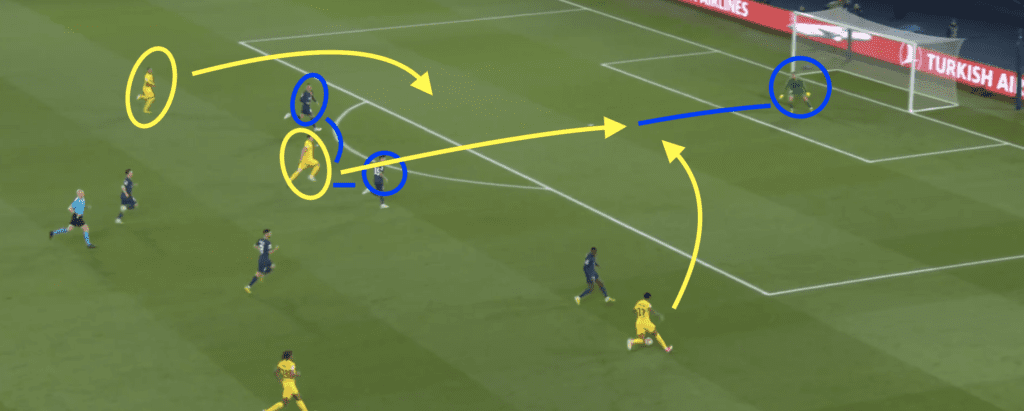
The Changes Made by Luis Enrique at Halftime
During the break, Luis Enrique makes some changes to PSG’s lineup, bringing in Bradley Barcola for Marco Asensio, who has been playing in a central attacking role. This move sees Barcola take over the right flank from Dembele, who now has more freedom and assumes a central attacking role, able to support both wings when needed. The other significant change is a rotation between Marquinhos and Luca Hernandez, with Marquinhos returning to his central role and Hernandez taking over at left-back.
Luis Enrique’s strategy for the second half is clear. He will use Mbappe and Barcola to create space for Dembele at the center. The strategy is largely the same as in the first half, except that this time, Dembele is responsible for finishing. It doesn’t take long for PSG to score using this exact tactic.
Dembele and the Equalizer
In the 48th minute, from a scramble in Barcelona’s half, the ball is played out to Dembele on the wing. Mbappe makes a swift run behind him into the box and receives a pass. De Jong and Kounde are drawn towards Mbappe near the touchline, and he manages to keep Dembele’s slightly overhit pass in play. The ball finds its way back to Dembele after two clearances from Araujo and Ruiz. This time, with more space, Dembele feints past De Jong and scores with a powerful and well-placed left-footed shot.
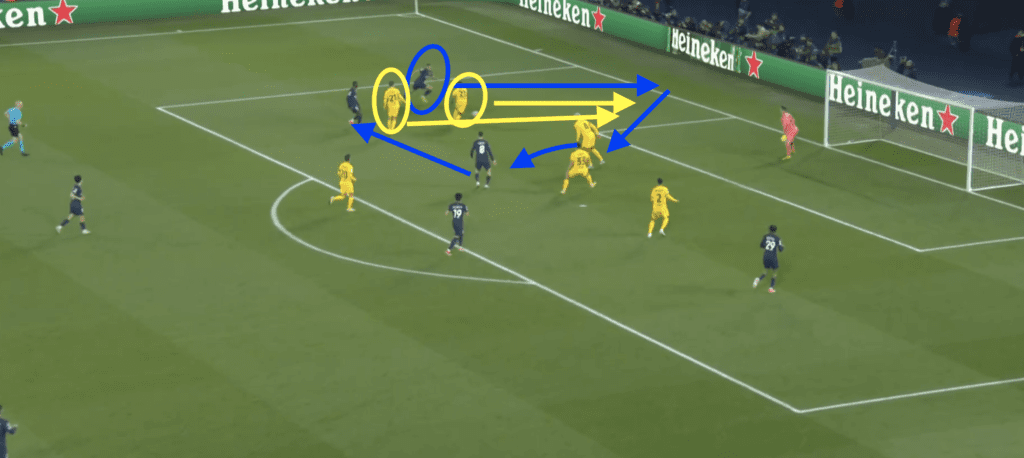
PSG’s Second Goal
PSG’s second goal comes just minutes later from a similar tactic. We can observe PSG’s build-up play in this sequence, with the two central defenders pushing wide, drawing Barcelona’s pressing to the left side of the pitch and forcing them to stretch their formation, before switching the play to the right side to Lucas Hernandez.
Hernandez carries the ball up to Barcola, who is supported near the touchline by Kang-in Lee, who draws the Catalan defense out wide, once again leaving space on the edge of the box for Fabian Ruiz. Ruiz finds Vitinha perfectly, who sprints into the box and sends a perfect pass to him. Now PSG takes the lead. I can’t help but compliment the excellent way in which Ruiz spotted and dropped into that free space, and PSG’s ability to open up those spaces.

Xavi Switches Things
The 61st minute sees the first substitutions for Barcelona, with João Félix replacing Lamine Yamal and Pedri coming on for Sergi Roberto, who was showing signs of fatigue. This means that in the new formation, Raphinha will play on the right wing instead of Yamal and João Félix on the left.
For the French side, Kang-in Lee is replaced by Warren Zaïre-Emery, a change from an attacking midfielder to a defensive one to help PSG maintain their lead.
Barcelona’s Second Goal
As with PSG’s goals, Xavi’s substitutions have an almost immediate impact. An error from Beraldo sees the ball intercepted, but Barcelona was unable to capitalize on this mistake, followed by Donnarumma’s clearance. However, the ball finds its way to Pedri, who has all the space he needs to send a precise long pass to Raphinha on the right wing. He manages to get past Nuno Mendes and then score. This time, Barcelona manage to profit from the defensive errors of the hosts, who were in a 3v3 situation. Just by looking at the below image, with all the Barcelona players lurking just in line with PSG’s defenders, waiting for that perfect long pass from Pedri.
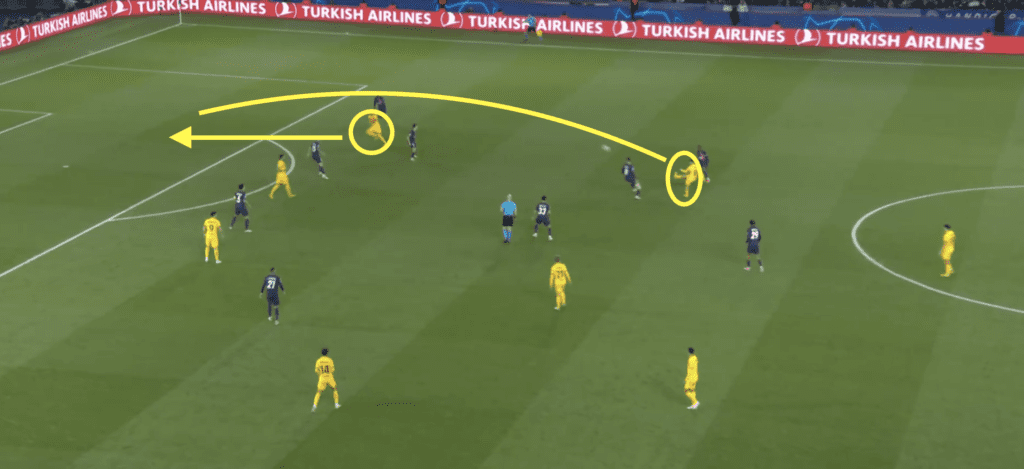
The Show Must Go On
The two teams keep trying to find gaps in each other’s defenses, but both teams have adapted well to the changes on the pitch and have managed to close down the wings well. One important moment to mention is a foul committed by Vitinha in the 68th minute in a dangerous situation.
Dembele loses the ball, which finds its way to Raphinha, who finds Lewandowski in a central position. Vitinha sees the dangerous situation and fouls Lewandowski from behind. What is important to note here is that Vitinha already has a yellow card, and although this foul is intentional, and was committed to prevent a dangerous situation, referee Anthony Taylor chooses to forgive him and not show him the second yellow card. Barcelona is awarded a free kick from 26 meters out, but Raphinha fails to convert it. Although he shoots well, Donnarumma manages to catch the ball.
It doesn’t take long for the French to respond with another dangerous situation exploiting Barcelona’s high defense, with an explosive run by Barcola from the left wing to the center of the pitch. The pass finds him and he escapes into a 1v1 situation with ter Stegen but is saved by Araujo’s exceptional intervention.
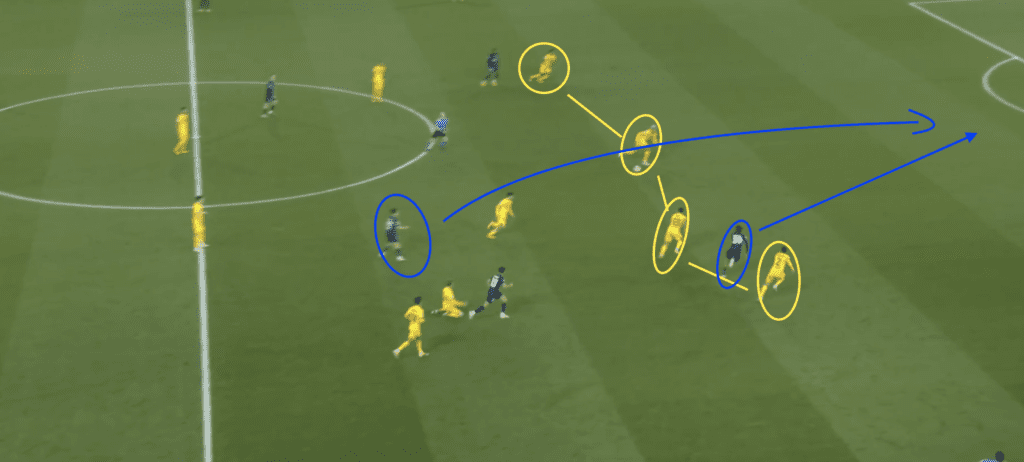
PSG Continues to Press for a Goal
This is the strategy that the French continue to use to try to regain the advantage, and they come very close to doing so just minutes after Barcola’s dangerous run. This time, PSG builds on the left wing, and Vitinha recovers the ball between two opposing players. As Barcola has moved to the right wing, just like in the goal phase, Dembele has more freedom, and this time, he is in the central-left area of the opponent’s box. Vitinha manages a through pass between the two defenders which reaches Dembele. He shoots precisely, but the left goal post saves ter Stegen.
The 76th minute sees more changes for Barcelona, with Andreas Christensen replacing de Jong and Ferran Torres replacing Raphinha. These changes are not necessarily tactical but rather to maintain a high level of energy on the pitch.
As we have become accustomed to in this match, the changes bring a bit of confusion to the opposing camp. Immediately after the changes, Barcelona takes advantage of PSG’s high press and sends the ball directly in the midfield with a long pass from behind. Lewandowski then passes to João Félix, who sends a beautiful curved pass to the newly introduced Ferran Torres. PSG is saved by a good intervention from Nuno Mendes, who manages to catch up with Torres despite starting at a slight disadvantage.
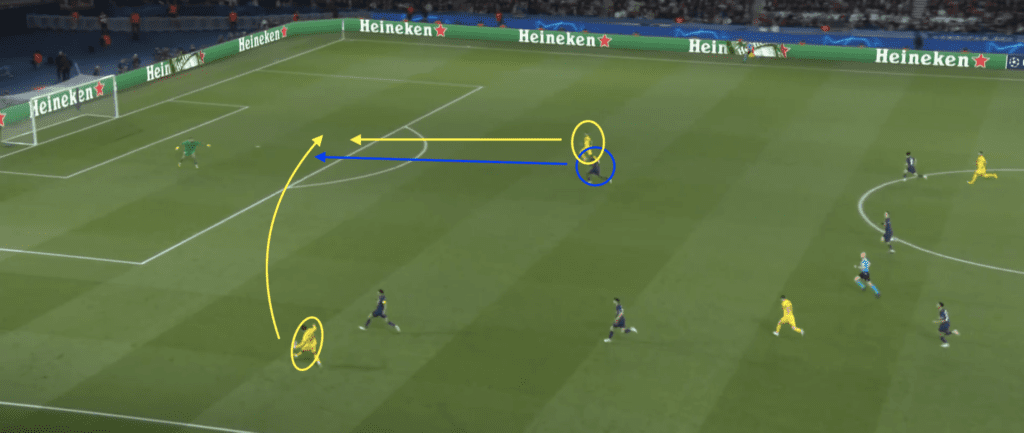
Barcelona Takes the Lead
PSG’s luck doesn’t last long, as Christensen scores from the resulting corner to give Barcelona the lead. This was a huge mistake by Donnarumma as he was indecisive. He wanted to come out to punch the ball, but chose to stay on his feet, and as a result Christensen managed to score from about four meters out, leaving him no time to react.
Of course, the remaining 10 minutes were controlled by PSG, who tried to break down Barcelona’s defense, but without success as they were focused on holding on to their lead, defending deep in a 4-4-2 formation with tight lines. On the attacking side, Barcelona slowed down their tempo. However, they did not hesitate if they did find an open passing lane. Here, a good example is a superb long pass from Cubasi to João Félix, who was eventually dispossessed by Nuno Mendes, holding on to the ball for too long.
Conclusions
This game shows us the importance of in-game management done by world-class coaches. All the goals in the second half come as a result of the tactical changes made by Luis Enrique and Xavi. Whether it’s Dembele, who had more freedom of movement and was able to be in the box to finish after Barcola came on and took the right wing, or the goal scored by Raphinha after his switch from the left wing to the right, this game has given us an unforgettable experience, filled with drama and excitement on both sides.

